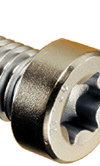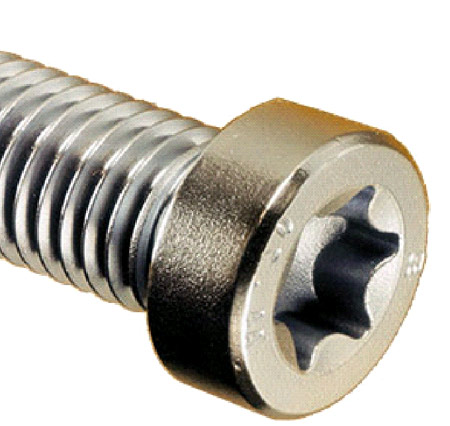Socket head fasteners with flank drive tightening features
 There is a fondness for using socket-head screws in race engines. They are neat, and one can use a number of them close together, allowing the use of high clamping forces. Taking the example of adjacent 6 mm metric screws, two socket-head types can comfortably be placed 10.5 mm apart, whereas two hexagon-head versions need 11.54 mm, plus tool clearance to allow for a socket or a wrench, between screw centres.
There is a fondness for using socket-head screws in race engines. They are neat, and one can use a number of them close together, allowing the use of high clamping forces. Taking the example of adjacent 6 mm metric screws, two socket-head types can comfortably be placed 10.5 mm apart, whereas two hexagon-head versions need 11.54 mm, plus tool clearance to allow for a socket or a wrench, between screw centres.
In many circumstances, socket-head screws also have advantages in terms of tool access. As engines and components become ever more compact, the use of smaller screws becomes more prevalent. However, in the case of small screws - and button-head screws in particular - the use of standard socket-head screws will often cause technicians who have to deal with these components to moan.
The reason is that the underhead friction is high, and the socket is small and often less than perfectly formed. Given that female hexagon drive features of all types drive on the corners rather than the flanks of the socket (there are special tools for male hexagon drives that drive on the flanks of the bolt heads), there is a tendency for small screws to 'round' - the annoying phenomenon where the socket deforms to leave a round hole, inside which the tool cannot drive.
At this point the technician has to resort to one of a number of time-consuming 'non-preferred tactics' for removing the fastener, which often involve a hammer and a punch or a chisel. Worn or undersized tools, slightly oversized sockets, and weak fastener material all serve to exacerbate this problem (always be aware of the grade of fastener that you are being supplied with).
So, what can we do to minimise the chances of rounding? Well, if we are already using a well made and strong fastener, then we need to look at an alternative to the hexagon socket drive. There are a number of designs that drive using the flanks of the tool, the most commonly known of which is called 'Torx'.
The general form of female flank drives is to shape the recess in the form of a multi-pointed star. While it is unlikely that the socket and tool are so perfectly formed that there is immediate full surface contact on all flanks, there is relatively little deformation required such that the drive is essentially one of face-to-face contact on each flank.
On a hexagon drive, the reaction of the 'points' of the tool are at 60º to the tangential drive direction, - that is, the reaction is more radial than tangential - and therefore there is a strong tendency for the screw material to be deformed outwards.

Flank drives have a much smaller angle between the tool reaction and the tangential direction, and therefore a relatively lower tendency to force material radially outwards. Also, there is a greater amount of material between the circles inscribing and circumscribing the socket feature for flank drives than hexagon sockets. Torx or similar pan-head screws seem generally preferred in small sizes where rounding is a common problem for these reasons.
Fig. 1 - Flank-drive socket-head screws offer advantages over conventional hexagon socket screws
Written by Wayne Ward